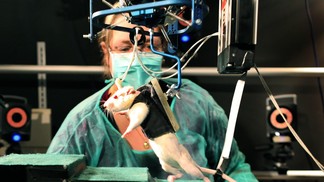May 12 2014
Grégoire Courtine, who holds the International Paraplegic Foundation Chair in Spinal Cord Repair, has been awarded a PROOF OF CONCEPT GRANT from the European Research Council (ERC).
 © 2014 EPFL
© 2014 EPFL
Once again, the excellence of the research performed at EPFL has been recognised at an international level.
Commercialisation of a robotic platform enabling high-precision force control in multi-dimensional application.
Current robotic technologies show severe limitations in multi-dimensional applications requiring force control, both from an accuracy and safety perspective. Although combined hardware and control concepts have been developed that enable accurate force control in a single degree of freedom, the majority of tasks necessitates superior force control capabilities in multiple degrees of freedom. We have developed a robotic platform that enables high precision force control in multi-dimensional applications. This system meets the requirements for safe and high fidelity body weight-supported gait training for rodents.
Our system consists of exchangeable and adaptable elastic force sensing modules that can be attached to state-of-the-art macrostructure robots and, combined with specific control laws, enable highly accurate force control along four independent degrees of freedom. The interface consists of a compact entity that is relatively light and can be produced at low cost. The goal is to develop a proposition package for potential investors. On the technical side we will create a novel prototype to validate our robotic technology. In consultation with regulatory specialists a roadmap will be developed to obtain regulatory approval based on the norms and procedures for robotics.
A patent protects our robot-assisted training and additional patents of our findings have been filed. A strategy to overcome any obstacles identified is being developed. Market opportunities for our technology include translational research, restoring fine locomotor and manual tasks in humans and industrial applications. These market segments will be extensively analysed and subsequently prioritised within the commercialisation strategy. Results will be assembled in a detailed business plan that is presented to several venture capitalists, existing robotic companies and other relevant stakeholders.